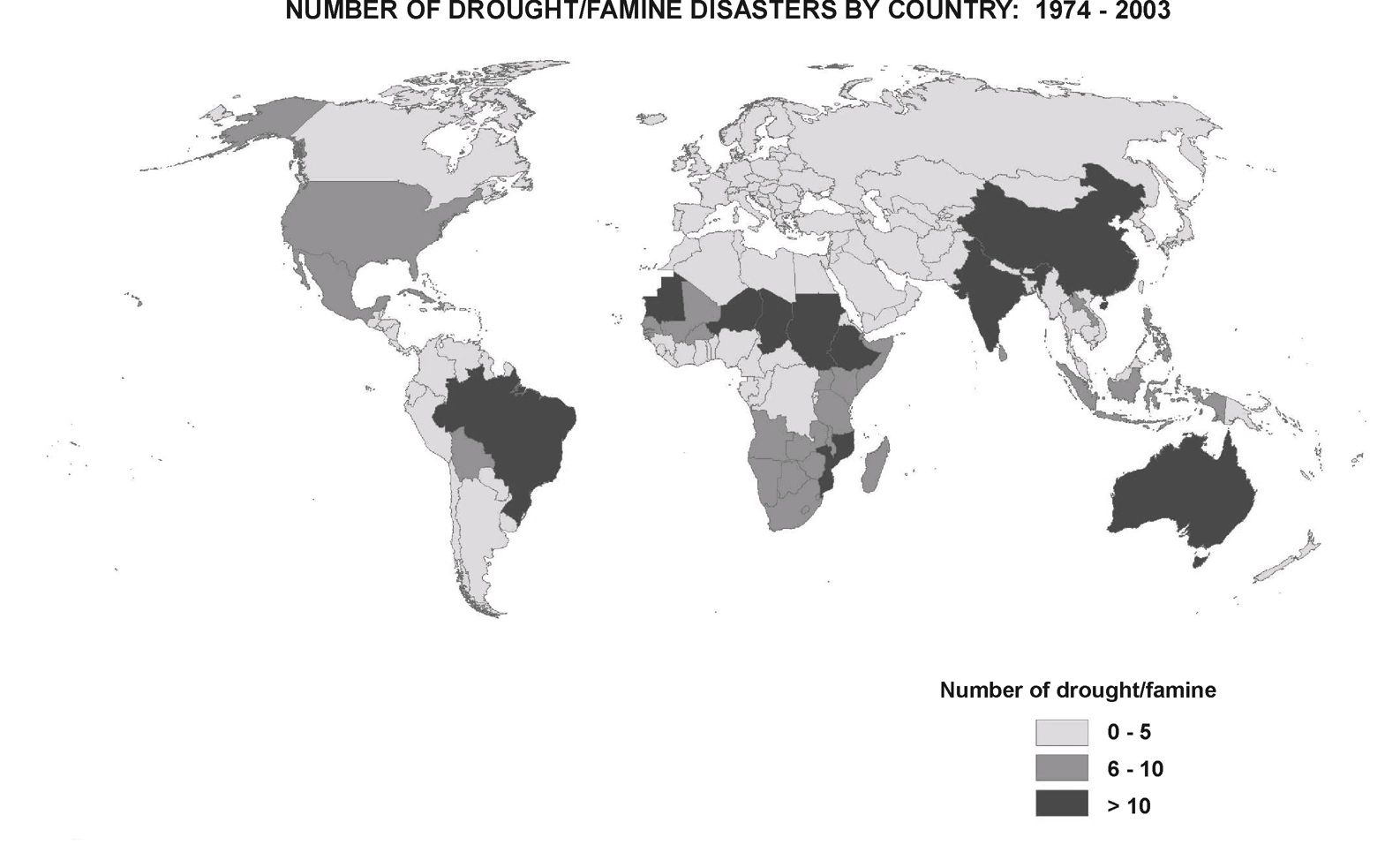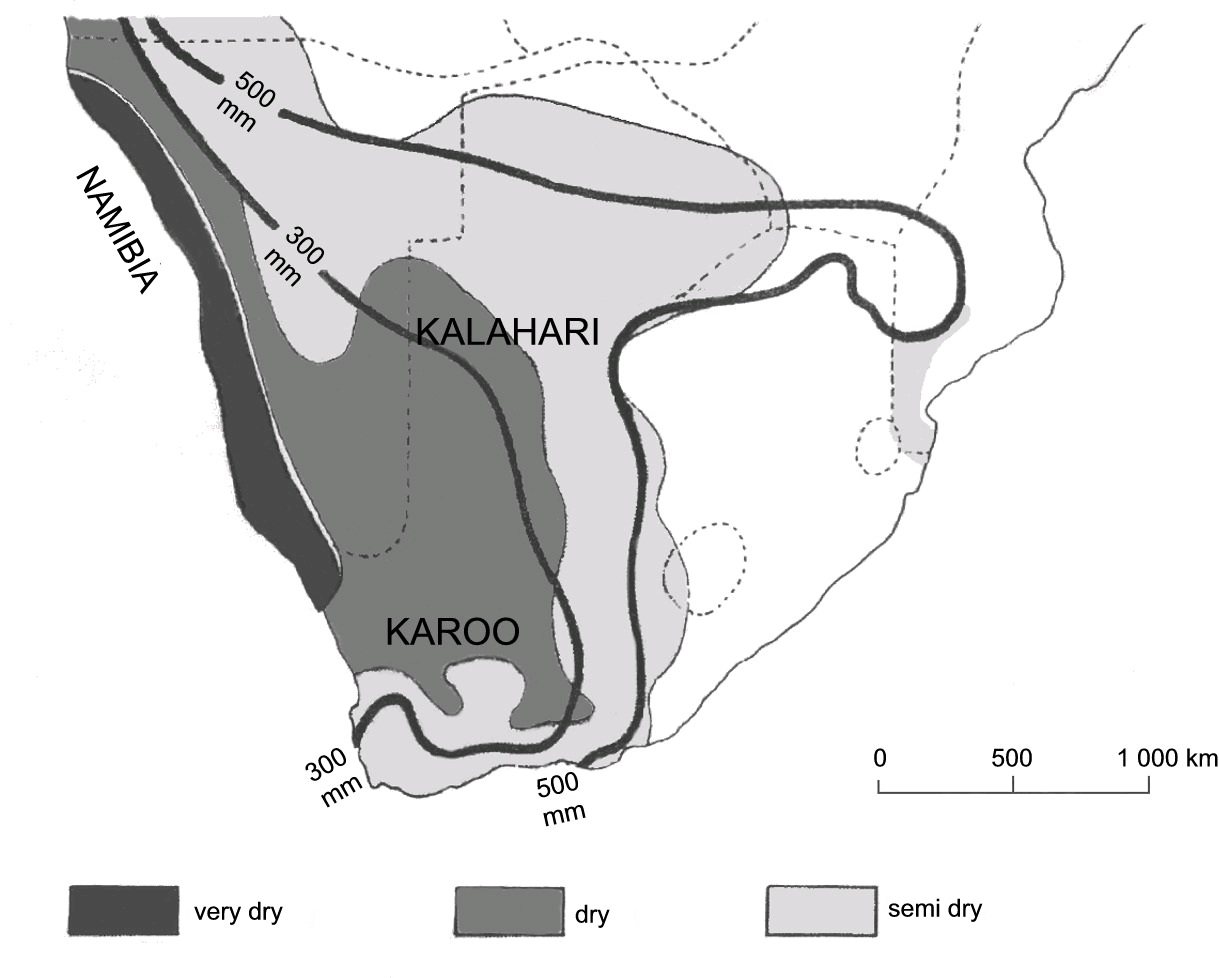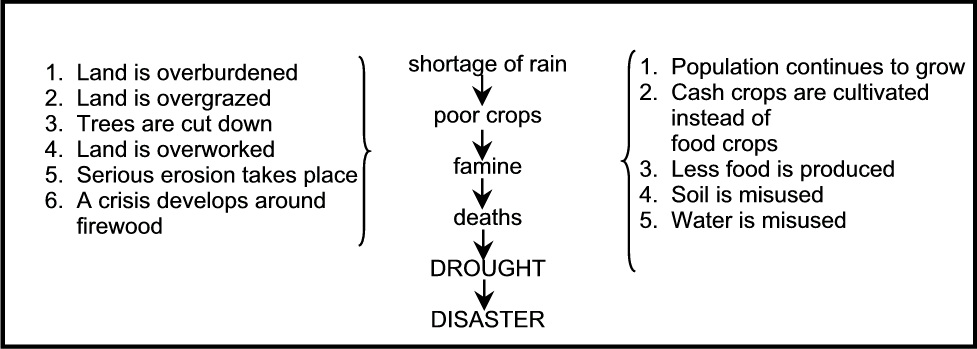
Geography Grade 7
By: Siyavula Uploader
Online: < http://cnx.org/content/col11021/1.1> This selection and arrangement of content as a collection is copyrighted by Siyavula Uploader.
It is licensed under the Creative Commons Attribution License: http://creativecommons.org/licenses/by/3.0/
Collection structure revised: 2009/09/09
For copyright and attribution information for the modules contained in this collection, see the " Attributions" section at the end of the collection.
Geography Grade 7
Table of Contents
Chapter 1. Term 1
1.1. The difference between natural disasters and natural hazards
SOCIAL SCIENCES: Geography
Grade 7
NATURAL HAZARDS
Module 1
The difference between natural disasters and natural hazards
Activity 1:
To study the dry regions of South Africa
[LO 2.1]
Activity 2:
To study the effects of droughts on people and areas
[LO 2.3]
Activity 3:
To do a case study on a serious drought in the country
[LO 2.3]
Assessment
Memorandum
1.2. Geographical phenomena
SOCIAL SCIENCES: Geography
Grade 7
NATURAL HAZARDS
Module 2
GEOGRAPHICAL PHENOMENA
Activity 1:
To hold a certain opinion about a geographical phenomenon
[LO 2.1]
Activity 2:
To make a list of the consequences a flood has for people
[LO 2.1]
Activity 3:
To study the impact of a flood on a residential area
[LO 2.1]
Activity 4:
To find solutions that will prevent floods
[LO 2.3]
Assessment
Memorandum
1.3. Tropical cyclones
SOCIAL SCIENCES: Geography
Grade 7
NATURAL HAZARDS
Module 3
TROPICAL CYCLONES
Activity 1:
To do research on the effect that tropical cyclones have
[LO 2.1]
Activity 2:
To study the effects of cyclones on people’s lives
[LO 2.1, 2.3]
Activity 3:
To plan to aid people in a disaster area
[LO 2.3]
Assessment
Memorandum
Chapter 2. Term 2
2.1. Earthquakes
SOCIAL SCIENCES: Geography
Grade 7
NATURAL HAZARDS
Module 4
Earthquakes
Activity 1:
To build a model of an earthquake
[LO 2.1, 2.3]
Where do most earthquakes occur?
Activity 2:
To indicate on a map of the world in which areas earthquakes occur
[LO 2.1, 2.2]
Activity 3:
To discuss the consequences of earthquakes
[LO 2.1, 2.2]
Activity 4:
To discuss the reason why people live in areas where earthquakes occur
[LO 2.2]
Activity 5:
To list emergency measures in case of an earthquake
[LO 2.3]
Assessment
Memorandum
2.2. Volcanoes
SOCIAL SCIENCES: Geography
Grade 7
NATURAL HAZARDS
Module 5
Volcanoes
Where do most volcanoes occur?
Activity 2:
To discuss the consequences of volcanoes on people and their environment
[LO 2.1, 2.2]
Activity 3:
To reflect on emergency measures in volcanic danger zones
[LO 2.3]
Assessment
Memorandum
2.3. The effects of population growth and change on the lives of people
SOCIAL SCIENCES: Geography
Grade 7
POPULATION GROWTH AND CHANGES
Module 6
The factors that influence growth and change
Activity 1:
To answer questions about the distribution of the world population
[LO 1.5]
Pg = B –D (+ or – net migration)
Activity 2:
To make inferences about population increase
[LO 3.2]
Activity 3:
To represent the differences in particular populations in pyramids
[LO 3.2]
Activity 4:
To discuss in groups the challenges for municipalities arising from increases
in the population
[LO 3.1]
Activity 5:
To choose the best options with regard to population changes
[LO 3.2]
Assessment
Memorandum
Chapter 3. Term 3
3.1. The effects of population growth and change on the lives of people
SOCIAL SCIENCES: Geography
Grade 7
POPULATION GROWTH AND CHANGES
Module 7
The effects of population growth and changeon the everyday lives of citizens
Activity 1:
To discuss questions on population density and urbanisation
[LO 1.2]
Activity 2:
To answer questions on migration in small groups
[LO 1.5]
Activity 3:
To establish where people prefer to live – in cities or in rural areas
[LO 3.3]
Activity 4:
To discuss the problems around migration
[LO 1.6]
Activity 5:
To list the effects on community life
[LO 3.2]
Assessment
Memorandum
Section A
Section B
3.2. Long term effects of migration on the population
SOCIAL SCIENCES: Geography
Grade 7
POPULATION GROWTH AND CHANGES
Module 8
The long term effects of migration on the population
Activity 1:
To illustrate the long term effect of migration on population structures
[LO 3.3]
Activity 2:
To discuss other reasons for migration
[LO 3.3]
Activity 3:
To do research on the effects of conflict and war on populations in Central
Africa
[LO 1.5]
Activity 4:
To give an informed description of the effects of war on the population
[LO 3.4]
Assessment
Memorandum
3.3. Population growth and change: the impact of HIV/Aids
SOCIAL SCIENCES: Geography
Grade 7
POPULATION GROWTH AND CHANGES
Module 9
Population growth and change: the impact of HIV/AIDS
Activity 1:
To make deductions from forecasts
[LO 1.2]
Activity 2:
To make deductions from a graph
[LO 1.2]
Activity 3:
To make deductions from a graph
[LO 1.2]
Activity 4:
To make deductions from newspaper articles
[LO 1.5]
Activity 5:
To make deductions from newspaper articles
[LO 1.5]
Activity 6:
To make deductions from newspaper articles
[LO 1.5]
Activity 7:
To report on making adjustments in various areas
[LO 3.1]
Activity 8:
To explain the symbolism of the AIDS ribbon
[LO 1.5]
Assessment
Memorandum
Chapter 4. Term 4
4.1. The reading, analysing and interpretation of topographical maps
4.2. Reading, analysing and interpreting vertical aerial photos and orthphoto maps
SOCIAL SCIENCES: Geography
Grade 7
MAP WORK
Module 11
Reading, analysing and interpreting vertical aerial photos and orthophoto maps
Activity 1:
To identify and interpret information on a topographic and orthophoto map of the
known environment
[LO 1.4]
Activity 2:
To identify a problem on an orthophoto map and to compare it with the real
situation
[LO 1.4, 1.5]
Activity 3:
To investigate an identified problem during a fieldwork excursion and to write a
report on it
[LO 1.6]
Assessment
4.3. Reading, analysing and interpreting vertical aerial photos and orthphoto maps
SOCIAL SCIENCES: Geography
Grade 7
MAP WORK
Module 12
UNDERSTANDING THE SYMBOLS ON A TOPOGRAPHICAL MAP
Activity1:
To understand the symbols on a topographical map
[LO 1.4]
Assessment
Memorandum
Index
Chapter 1. Term 1
1.1. The difference between natural disasters and
natural hazards*
SOCIAL SCIENCES: Geography
Grade 7
NATURAL HAZARDS
Module 1
The difference between natural disasters and natural hazards
Natural hazards are geographical events which occur naturally UNDER (earthquakes and
volcanoes), ON (floods) or ABOVE (climatic conditions such as droughts and tropical
cyclones) the surface of the earth. Things such as droughts, floods, tropical cyclones, volcanic eruptions and volcanoes regularly happen on a small scale throughout the world. However, if
one of these natural hazards leads to – a significant loss of human life and/or – damage to
property, and/or – environmental damage,it is called a NATURAL DISASTER.
Disasters know no boundaries, and can lead to the loss of thousands of human lives in the areas where they occur.
1. Droughts
1.1 The occurrence and cause of droughts
1.1.1 What are droughts?
A drought is a continuous and lengthy period during which there is no or insufficient precipitation.
Thus it is associated with a lack of water, but it does not always lead to a disaster. It is the relationship between the community and their environment that will determine whether a drought will develop into a disaster or not. Isolated droughts rarely occur out of the blue. They usually

creep up on a community over several years.
1.1.2 Where do droughts occur?
Study figure 1. It is a world map showing the areas where most droughts occur. You will note that certain countries experience more droughts than others, but that the African continent and India suffer the most from serious droughts.
Figure 1.1.
Figure 1
Activity 1:
To study the dry regions of South Africa
[LO 2.1]

Figure 1.2.
Figure 2
a) Make an estimation as to what percentage of South Africa experiences rainfall of less than 500
mm per year.
b) Where in South Africa are droughts most likely to occur? Why?
c) Where in South Africa are droughts least likely to occur? Why?
d) Name ways in which a farmer in the Northern Cape can take precautionary steps against future droughts.
1.1.3 What causes droughts?
Water is essential for life on earth. A drought is the result of a lack of water. Many people think that a drought occurs merely because it doesn’t rain. A decrease in rainfall does indeed cause droughts, but this is not the only cause.
Study table 1, which shows how other factors can lead to the disastrous conditions which are associated with droughts.
Table 1:

Figure 1.3.
Thus changes in climate are indeed implicated in droughts, but poor environmental management has a greater influence on the disastrous impact of a drought.
1.2 The effect (consequences) of droughts on the lives of people and their socio-economic
activities
During a period of about 10 years approximately 60 million people worldwide are affected by
droughts, and this number continues to increase. In the 1990s, in Africa alone, 35 million people were affected by drought. What will the situation be in the future?
Study the following list of consequences of droughts:
no crop rotation
failed crops
famine: less food is produced
loss of lives
wells dry up as a result of the lowered water table
stock are slaughtered on a large scale: meat prices fall
hydro-electric plants may stop operating: electricity prices rise
unschooled labourers earn less income: poverty
water restrictions are imposed
industries suffer due to a lack of water
vegetation dies and disappears
dust bowls develop on bare soil, and air pollution worsens
dust bowls develop on bare soil, and air pollution worsens
workers lose their jobs and their income: unemployment causes crime
increasing population places more strain on the environment and a vicious circle of disasters develops
water levels of rivers and dams fall and some dry up completely: fish die
a decrease in the gross national product (GNP) of the country
desertification of marginal areas
people are forced to migrate out of drought-ridden areas: many are unschooled
Activity 2:
To study the effects of droughts on people and areas
[LO 2.3]
1.3 Why are some people at a greater risk than others?
It is important to remember that the relationship between humans and their environment
determines whether a drought will deteriorate into a disaster.
If we take another look at figure 1 (world map showing where most droughts occur), we see that droughts most often occur in the poorer, developing countries of the world. Why?
Because of their disadvantaged status they still believe that power lies in numbers, and that parents should have many children who can take care of the parents in the future. This leads to a great number of births and an increasing population.
Food is only cultivated for personal domestic use. No fertilisation takes place. Over the years the soil becomes impoverished and harvests decrease in size. Less food is produced.
Soil is misused over a long period and no fertiliser is added.
Irrigation, if available, is applied incorrectly and this exacerbates erosion.
Owning a herd of cattle is of great importance to these people, because to them this represents great wealth. Too many cattle are placed on a piece of land with the result that overgrazing destroys the vegetation. This leads to erosion.
Erosion removes the fertile topsoil, the soil becomes impoverished and production is further Erosion removes the fertile topsoil, the soil becomes impoverished and production is further reduced.
In addition, poor people do not have access to electricity, and they have to rely on wood fires for heat. Thus many trees are destroyed for firewood. This in turn reduces the soil’s water
retention capacity, which causes water to evaporate faster.
Disastrous droughts also occur in developed areas, such as the current drought in the Western Cape of South Africa. Yet the fact remains that rich people seldom die as a result of droughts.
They can survive because they have other assets which can carry them through the difficult times.
However, the large, rich farmers and/or companies are also sometimes destroying the environment with their enormous developments.
1.4 Preventative measures: risk management and risk reduction
When you read the newspaper, or watch or listen to the news, you will undoubtedly become aware of a drought somewhere in South Africa. Look at figure 2 again, which shows the dry areas in South Africa. It is not surprising that South Africa experiences many droughts.
Are there possible solutions to the drought problem? Although it is not always possible to carry out all the steps needed to solve the problem, we can take a look at some of the things that can be done:
building dams to accumulate water
sinking boreholes and erecting windmills
desalinating sea water
establishing water installations through the use of pipelines
melting icebergs
cloud seeding and rain making
population management
careful management of soil and water resources
controlling soil erosion
planting trees
attempting to reclaim soil through the use of drought-resistant seed
Activity 3:
To do a case study on a serious drought in the country
[LO 2.3]
Do a case study on a serious drought in South Africa. Compare it with the information you have gained so far, and then write an essay about:
a) the causes
the consequences
c) possible solutions for disastrous droughts.
Assessment
Table 1.1.
Learning Outcomes(LOs)
LO 2
GEOGRAPHICAL KNOWLEDGE AND UNDERSTANDINGThe learner will be able to
demonstrate geographical and environmental knowledge and understanding.
Assessment standards(ASe)
We know this when the learner:
2.1 describes and explains how natural hazards such as volcanoes, earthquakes and flooding
occur, and their impact on human lives and socio-economic activities [people and places];2.2
investigates and explains why some people face a higher risk than others with respect to natural hazards [people and resources];2.3 identifies how risks and hazards can be managed [people and the environment].
Memorandum
Activity 1:
1. Approximately 60%
2. North-Western Cape and the Karoo.
1. The area lies far from the rainy eastern coast where hot, humid air flows into the country. As the hot, humid air is







